This 508-million year-old sea creature was a cousin to the scorpion, researchers say

 File this one under creepy or cute, either way, you’re probably not wanting to find a Habelia optata in your Christmas stocking this year, as the extinct, multi-limbed creature was likely one tough customer.
File this one under creepy or cute, either way, you’re probably not wanting to find a Habelia optata in your Christmas stocking this year, as the extinct, multi-limbed creature was likely one tough customer.
Researchers from the University of Toronto and the Royal Ontario Museum in Toronto have made a new discovery on the 500-million year old species, one which scientists have known about for over a century but had yet to properly classify within the animal kingdom.
Now, a comprehensive study of the creature involving 41 different specimens has led researchers to conclude that the sea-dwelling Habelia optata was indeed an arthropod ancestor to the sub-group called chelicerates, which includes horseshoe crabs, sea spiders, scorpions and spiders.
“Scorpions and the now-extinct sea scorpions are also chelicerates with bodies divided into three distinct regions,” says Cédric Aria, graduate of the U of T’s Department of Ecology and Evolutionary Biology and lead author of the new study, currently at the Nanjing Institute of Geology and Palaeontology in China. “We think that these regions broadly correspond to those of Habelia. But a major difference is that scorpions and sea scorpions, like all chelicerates, literally ‘walk on their heads,’ while Habelia still had walking appendages in its thorax.”
Coming from the Burgess Shale deposits in Yoho National Park in British Columbia, the Habelia fossils date to the middle Cambrian period, with 27 specimens collected by the Royal Ontario Museum in the 1990s. Researchers needed to prepare the specimens in such a way that their 3D nature and hidden body parts were made more apparent under the microscope and through photographing the specimens with a variety of lighting techniques.
The team then created technical drawings as well as 3D animations of Habelia to produce what Aria calls “one of the most technically challenging 3D reconstructions of a Cambrian animal described thus far.”
Only two cm long and with a tail as long as its body, Habelia had five sets of appendages on its head, including a large plate with teeth for chewing, a leg-like branch for grasping and a longer, thinner branch likely for touching and sensing.
Habelia optata was an “exceptional predator”
“This complex apparatus of appendages and jaws made Habelia an exceptionally fierce predator for its size,” said Aria. “It was likely both very mobile and efficient in tearing apart its preys.”
The creature is thought to have been a bottom-dwelling hunter, feasting on small shelled arthropods like trilobites along the ocean floor.
“The appearance and spread of animals with shells are considered to be one of the defining characteristics of the Cambrian explosion,” says Aria, “and Habelia contributes to illustrate how important this ecological factor was for the early diversification of chelicerates and arthropods in general.”
Classifying Habelia optata as a chelicerate rather than as a member of the other main arthropod group, the mandibulates, which includes shrimps, crabs and centipedes, is an instance of what is known as morphological convergence. Although the animal’s head appendages bear a resemblance and similar functionality to those found in mandibulates, the similarity is a product of practical coincidence rather than evolutionary lineage, much like the presence of wings expresses morphological convergence on species like birds and bats.
The new study is published in the journal BMC Evolutionary Biology.

